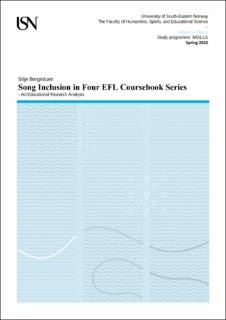| dc.description.abstract | When songs are used pedagogically in English language learning, they can implicitly facilitate natural language in meaningful contexts. Songs make for effective and successful language learning by providing language in chunks followed by a melody. The repetitive quality of songs enables learners to store information in their long-term memory, thus language is easier accessible during communication. Participating in choral singing creates a learning situation where students can engage at their own level, with rhythmic movements and singing the words they know, while observing peers model the parts they are about to learn. This can increase students’ self-confidence and the feeling of belonging. Additionally, it is crucial to build a good motivational foundation in young learners, especially when learning a new language. Songs are a natural part of many children’s cultures and therefore a method they already know and enjoy.
EFL coursebooks in Norway are based on the Knowledge Promotion, they should therefore provide content based on the English curriculum. One competence aim in the LK20 includes singing, but several other aims could be met through songs. Since literature supports the benefits of using songs as method in language learning and competence aims can be met through songs, coursebooks should include songs. This research aimed to investigate the inclusion of songs in four EFL coursebook series targeted towards first graders while also examining if teachers could rely solely on coursebooks for including song materials.
Through a qualitative content analysis, trends and patterns of quantity, type, and purpose of songs were detected. It became evident that the coursebook series varied a lot. All coursebooks included songs, however some had more static songs while others had more traditional songs. All coursebooks did have songs with a learning purpose, but not all had thematical songs included. The coursebooks series’ differences affect what type of language students meet through songs, and if songs are used for explicit language topics or not. Findings also revealed that the strongest inclusion of songs was in the teacher’s guides, both the pupil’s books and the digital learning platforms had included songs in varying degrees. This makes teachers responsible for including most of the songs suggested, and the quality of songs as method is therefore conditionally related to the teachers’ beliefs. Additionally, since each coursebook series excelled in different ways, there are several factors that teachers need to be aware of, thus teachers cannot rely solely on coursebooks for including song material. | |
